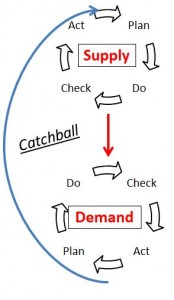In two recent blog posts, CAP-Do supports Outcome Driven Innovation and Lean Sales Process does not Start at Plan or Build, I discussed how companies that apply Lean to Sales and Marketing think incorrectly in terms of PDCA versus CAP-Do. In summary, we need to change to an outcome based approach and for a Lean Enterprise that means the co-mingling of Supply and Demand through PDCA and CAP-Do.
I am a firm believer that a Lean Enterprise will outperform most other types of organizations. However, that advantage is being minimized, through a focus on internal operations versus become more externally focused. I have previously viewed PDCA (Kaizen) as the culture of Lean. I asked that question of Dr. Balle and he explain in this youTube video, Is PDCA and Kaizen the culture in a Lean Enterprise? I still agree with these thoughts for the supply side of the organization. On the demand side, I believe that CAP-Do is the predominant thinking needed in a Lean Enterprise. I have supported that premise in the cited blog posts above and many other writings.
The purpose of this blog post is how you co-mingle the Supply side of PDCA and the Demand side of CAP-Do. My thoughts of applying Lean center on developing deeper perception of customers and experiences they should have with us. It is the collective thought and how we develop that in our interactions. This is what makes Lean powerful. The CAP-Do cycle symbolizes this process. Lean Engagement teams face new challenges that are solved by collective thought. This collective thinking needs to be done internally, externally and across organizations. It will not come naturally and needs to be created and learned. Lean provides that opportunity.
 On the Demand Side: I take a slightly different approach than many others when I interpret the Act or Adjust stage in CAP-Do. I view the A, not as a method to prepare for Plan but to connect, with others, to see divergent views. Where C was about factual listening and measurement, A is about empathetic listening. It is where we look and listen through the eyes and ears of our customer before proceeding. It is not an easy process to accept different and often times opposing views. When considered, these views should not cause us to making adjustments in the Plan stage of PDCA. Rather, it should cause us to PAUSE.
On the Demand Side: I take a slightly different approach than many others when I interpret the Act or Adjust stage in CAP-Do. I view the A, not as a method to prepare for Plan but to connect, with others, to see divergent views. Where C was about factual listening and measurement, A is about empathetic listening. It is where we look and listen through the eyes and ears of our customer before proceeding. It is not an easy process to accept different and often times opposing views. When considered, these views should not cause us to making adjustments in the Plan stage of PDCA. Rather, it should cause us to PAUSE.
On the Supply Side: We start with Plan (PDCA) but forget to download the customers’ outcomes or what they are trying to achieve. We assume the tacit knowledge within our company is far better than co-created knowledge. What we must do it take the co-create knowledge create in the first part of CAP-Do make it explicit. Without this, we have a tendency to use our preconceived thoughts and proving our own hypothesis in isolation, without our customer. We are stuck in one view. We proceed to the Check/Study and the answers are manipulated and Adjust is just confirmation on the results that we wanted.
Demand & Supply: What must happen is that the Supply side must interact with the Demand side before either side starts and definitely before completing the Plan stage. It is during Plan that we can arrive at an organizational hypothesis that is complimentary of both sides. It is an enactment of catchball often used in Hoshin Kanri. Sales and marketing (Demand) validates its beliefs (Check) with the customer (ACT) and gives the ball to the internal Operation (Supply) side. This may be in terms of a forecast, orders, innovation, feedback or any insights required for operations to perform their duties. Operations (supply) will coordinate their efforts to toss the ball back to Sales and Marketing (demand) when they pause at before their Check Phase. This way there is a constant effort of catchball between Operations (supply) and Sales and Marketing (demand) with overlapping responsibility. This overlapping responsibility goes a step further as Sales and Marketing (demand) interacts with customers during the Act stage.
Sounds a lot like Leader Standard Work?
